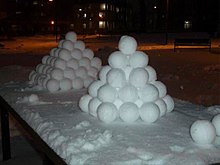Snowball




A snowball is a spherical object made from snow, usually created by scooping snow with the hands, and compacting it into a roughly fist-sized ball. The snowball is often used to engage in games, such as snowball fights. Snowball fights are usually light-hearted and involve throwing snowballs at one's friends or family. The pressure exerted by the hands on the snow is a determinant for the final result. Reduced pressure leads to a light and soft snowball. Compacting humid or "packy" snow, by applying a high pressure produces a harder snowball or iceball, which eventually can be considered harmful during a snowball fight.
A snowball may also be a large ball of snow formed by rolling a smaller snowball on a snow-covered surface. The smaller snowball grows by picking up additional snow as it rolls. The terms "snowball effect", "snowballing" and "Y Gasseg Eira" are named after this process. This technique is often used to create snowmen. Often a snowman can be created using this method of snowballing, to create the sections needed to build the sculpture.
There are some temperature/humidity ranges that prohibit or restrict the formulation of a snowball. With a powdery snow, snowballs are difficult to form. In temperatures below 0 °C (32 °F), there is little free water in the snow, which leads to crumbly snowballs. At 0 °C (32 °F) or above, melted water in the snow results in a better cohesion. If you're walking on snow and it squeaks, chances are the temperature/humidity level won't form a snowball, because squeaking means that the snow is dry.
Self rolling snowballs[edit]
Under certain, rarely occurring circumstances, self rolling snowballs form on their own.
These circumstances are:
- The ground must have a top layer of ice. This will prevent the snowball from sticking to the ground.
- That ice has to have some wet and loose snow that is near its melting point.
- The wind has to be strong enough to push them. Yet, it cannot be too strong.
- Also, gravity could cause the snowballs to form instead of the wind.
Because these conditions have to take place at the right place in the right time, it is considered a phenomenon.[1]
See also[edit]
References[edit]
- ^ Rare self-rolling giant snow balls found in UK, The Telegraph, January 8, 2010
da:Snebold it:Palla di neve lb:Schnéiklatz lt:Sniego gniūžtė no:Snøball nn:Snøball pl:Śnieżka (kulka) fi:Lumipallo
